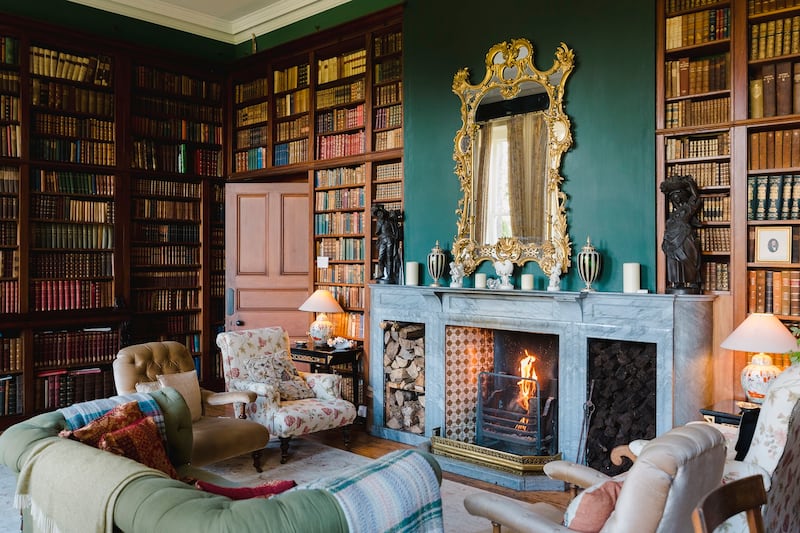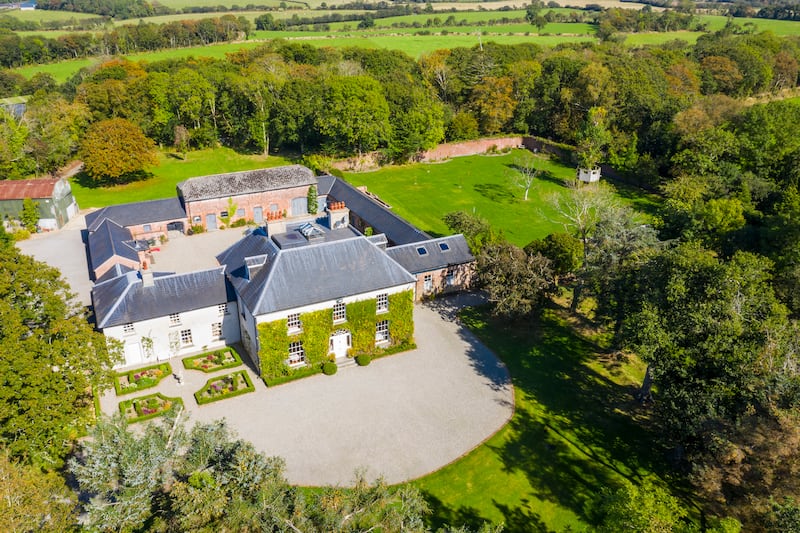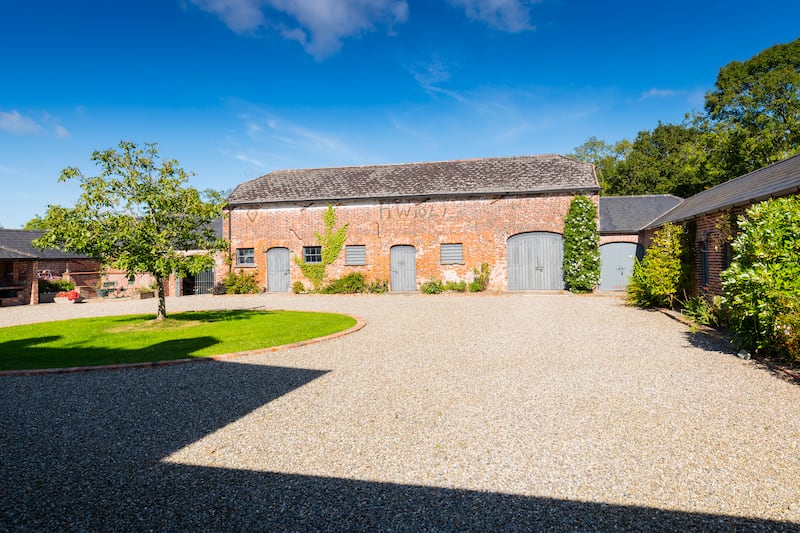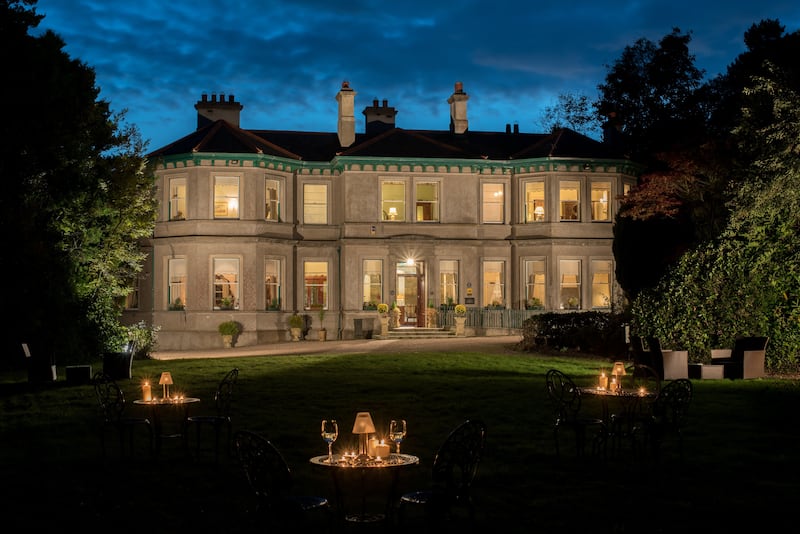I grew up watching Upstairs Downstairs, fascinated by the fine drawingrooms and the elegantly groomed people who inhabited them. Look at that, five-year-old-me thought – Lord and Lady Bellamy ring a bell and Hudson or Rose or a random footman miraculously appear. In my 30s, I switched allegiance to Downton Abbey, fascinated by the weekly exploits of Lord Grantham and Lady Mary, Cousin Violet and Mrs Hughes.
I grew up just a few fields away from one of Sligo’s finest country houses, Coopershill, set in 500 acres of farmland, deer pastures, woodland and gardens overlooking the river Unsin. A three-storey Georgian mansion, it was built in the 18th century for current owner Simon O’Hara’s great-grandfather’s great-grandfather, Arthur Cooper.
In the absence of Downton’s butler Carson, I help myself to home-made muesli with honey from the estate bees and rhubarb compote from the garden
Although the house has been taking in guests since the 1970s, I’d never even set eyes on it – the mile-long avenue from the road took care of that. A few hundred years ago I’d probably have been a servant in the kitchen rather than a bell-ringing lady, but recently I finally got to step through its front door.
Which is, incidentally, the tallest front door in Sligo – specially created so Arthur Cooper could ride his horse into the hallway. I meet Arthur in the diningroom at breakfast the next morning. He looks down from over the fireplace, alongside a buffet table of delicacies laid out Downton-style. In the absence of Downton’s butler Carson, I help myself to home-made muesli with honey from the estate bees and rhubarb compote from the garden.
Netflix, Prime Video, Disney+, Apple TV+: 10 of the best new shows to watch in May
Five things your estate agent is too afraid to tell you
‘Forget about glamour’: Jonathan Anderson offers advice to would-be fashion designers as he receives TCD honour
Death of Pope Francis: Derek Mooney leads RTÉ’s coverage to intermittently jaw-dropping effect
Mary comes through from the kitchen to tell me she’ll be cooking my breakfast, award-winning bacon and sausages from local Ballymote butcher Adrian Sheerin and eggs from Ballysadare hens down the road. Simon goes around the tables, offering suggestions for things to do in the area, as benevolent as Lord Grantham, though a lot less suspicious of strangers in his home.

“It’s just like it was in the old days,” he tells me. “The house was built for guests, there are 11 bedrooms, more than the family needed. It was built so visitors could be entertained to lavish hospitality and wander around the grounds – and it still happens today, only now they discreetly slip us money as they leave.”
Downstairs at dinner, the Riverstown lamb has had a short trip to my plate, while the mushrooms and wild garlic were foraged in the grounds
Simon lives here with his wife Christina and their two sons. Their portraits – pencil sketches and photographs – have been added to the family collection in the grand reception rooms. Everywhere, from the drawingroom with its beautiful river views to the landings and staircases, is a treasure trove of family possessions: a stags’ head and vintage luggage, china dinner sets and a 5,000-year-old paddle.
In my top-floor bedroom, it’s easy to imagine ringing a bell to summon pitchers of hot water – but easier to turn on the taps on my free-standing bath, perfectly placed for a view of the humpbacked bridge. It’s an eclectic mix of old world and new, underfloor heating and antique wardrobes.
Downstairs at dinner, cooked by Christina, the Riverstown lamb has had a short trip to my plate, while the mushrooms and wild garlic were foraged in the grounds. During the summer months the estate’s own gardens produce most of the vegetables.
Later, relaxing in front of the drawingroom fire with a slice of Christina’s lemon cake, I’m nearly hysterical with excitement when I see the old-fashioned push-button bells by the door. My inner Lady Bellamy is finally content.
Coopershill House is open from mid-March to the end of October each year; Doubles €299. Coopershill.com
Other Irish country retreats ...
Ballyvolane House, Fermoy, Co Cork; Ballyvolanehouse.ie
With three lakes and woodlands, duck and pheasant shooting, farmyard animals to feed and its own gin distillery, the grounds of Ballyvolane House in Fermoy are well equipped to keep guests entertained. Inside the 18th century home there’s plenty more on offer – six double bedrooms, a series of well-appointed reception rooms and a baby grand piano in the pillared hall. If it sounds fit for royalty, well it is – former guests include HRH The Prince of Wales and HRH The Duchess of Cornwall, who stayed here in 2018. Food, freshly prepared and home-grown, comes either from the walled garden, estate farm or local artisan producers. If you want to eat out, the gourmet restaurants of Kinsale or Ballymaloe House are on the doorstep. Built in 1728, the luxurious family home has been welcoming guests for two generations and is open year-round. If you fancy glamping in the grounds, you can stay in a bell tent or ark between May and September. Doubles from €280, tents from €350 for two nights.


Clonalis House, Castlerea, Co Roscommon; Clonalishouse.com
Ancestral home of the O’Conor family, direct descendants of the last High King of Ireland and the Kings of Connacht, owner Richard O’Conor Nash is the 27th generation to live here. There are just four double guest rooms in this Victorian pile, a large Italianate building on a wooded 700-acre estate on the banks of the River Suck, a mile from Castlerea. There are roaring log fires, cosy sofas to recline on and a library to explore. Bedrooms, with parkland views, are furnished with four poster beds and antiques. You can browse family heirlooms and memorabilia, including the harp of famous blind musician Turlough O’Carolan, and they’ll even lend you wellies so you can explore the grounds – maybe with the family dog in tow. The cooking is described as pedigree Irish countryside delivered with passion – seasonal produce from local artisan producers and suppliers, alongside ingredients foraged from the estate. The house is open from April to the end of September, and self-catering cottages in the grounds are open year-round. Doubles from €215.

Clonganny House, Ballygarret, Co Wexford; Clonganny.com
Clonganny House is close to the cliffs and golden beaches of north Co Wexford, an hour’s drive from Dublin. It was originally built in 1823 for Henry White, son of the notorious priest hunter and magistrate Hawtrey White, known locally as Hawtrey The Alarmist. His initials can still be seen in giant letters on the outside of the coach houses. Set in eight acres of gardens and woodland, guests also have access to a beautiful walled garden. Each of the house’s four courtyard suites, with bedrooms and sitting areas, open on to private patios within the walled garden, close to the woods. The building’s classical Georgian-era features, including sash windows, shutters, hardwood floors and ceiling roses, have been beautifully preserved; dining and drawingrooms still have their decorative period fireplaces. Suites from €264.


Ballyfin Demesne, Ballyfin, Co Laois; Ballyfin.com
The 19th-century family home of Sir Charles Coote, a descendant of the Elizabethan Sir Charles who first came to Ireland in 1601, is today a glamorous 5-star hotel. Set in over 600 acres at the foot of the Slieve Bloom mountains, it’s small by most hotel standards, with just 20 rooms. It also has an indoor swimming pool, gym and treatment rooms. The Regency mansion was built in the 1820s by the famous Irish architects Sir Richard and William Morrison, and the Coote family lived here for 100 years. They sold it to the Patrician Brothers, who ran it as a school in the 1900s, and it has been a hotel since 2011. But they’ll still treat you like a house guest, with uniformed valets to unload your car on arrival, and staff who can talk you through the history of the house like it’s their own. You can take bikes, horses, a carriage or just yourself around the grounds, row on the estate’s lake or take part in clay pigeon shooting, archery and falconry. Doubles from €640.

Ardtara House, Upperlands, Co Derry; Ardtara.com
Built by adventurer and businessman Harry Clark in the late 1800s, the story of the house is entwined in Northern Ireland’s historic linen tradition. Born into a long line of wealthy linen barons, Harry wanted to roam the world but was enticed into the family firm with the promise of global business travel. He built picturesque Ardtara House, conveniently situated between Derry and Belfast, as a comfortable home to return to. Today it stills feels like a grand family residence with lots of home comforts; eight of the nine bedrooms have working fireplaces, as does the elegant drawingroom. Some of the original furniture remains and there’s a baby grand piano in the entrance hallway if you’re in the mood for a tune. Dinner in the wood panelled diningroom is a bit of a treat, served up by co-owner and chef Ian Orr, who also co-owns Browns Bonds Hill and Browns in Town in Derry, regularly cited by food critics as two of the best restaurants in the city. Doubles from £205 (€232).


Opening in 2023: Brandondale House, Graiguenamanagh, Co Kilkenny; @brandondalehouse
Currently being restored by a local couple with a passionate desire to preserve a piece of national history, Brandondale House will open to the public later this year. The 18th century Regency villa, with spectacular views over the river Barrow and beyond to Mount Leinster and the Blackstairs, was built as a family home for the Burtchaells. They made their money in the thriving local linen industry, and Sarah, the last of the family to live there, fittingly took in paying guests to cover running costs until her death in the early 1900s. The shady woodland walk in the grounds has been immortalised in the short story The Trout, by Sean O’Faolain, who spent three summers at Brandondale in the 1940s. Located behind the walled kitchen gardens and known as “the Dark Walk”, it leads to a gothic Victorian tea house with medieval window and door openings from a nearby abbey.













